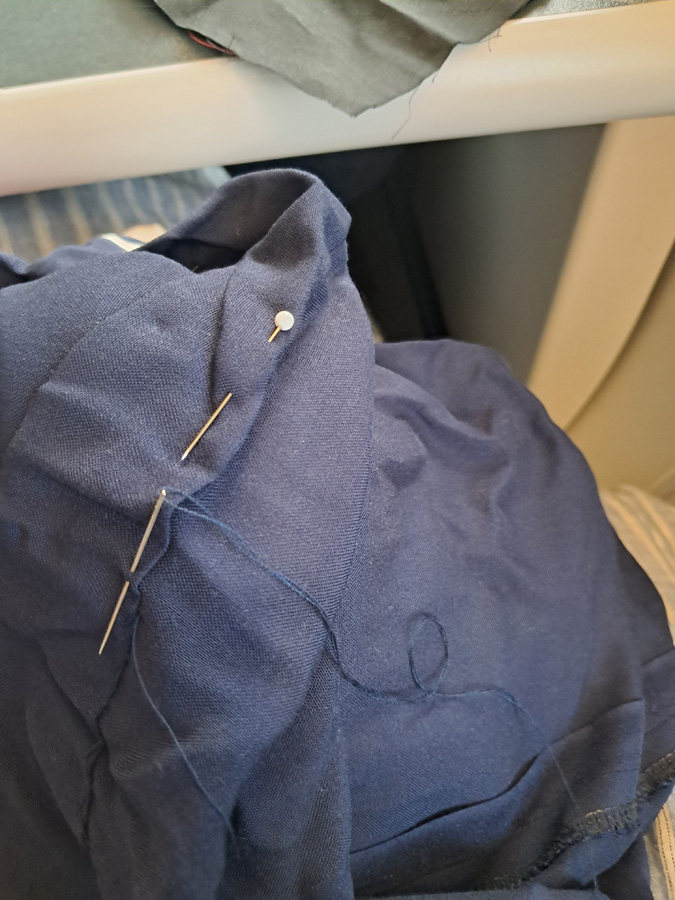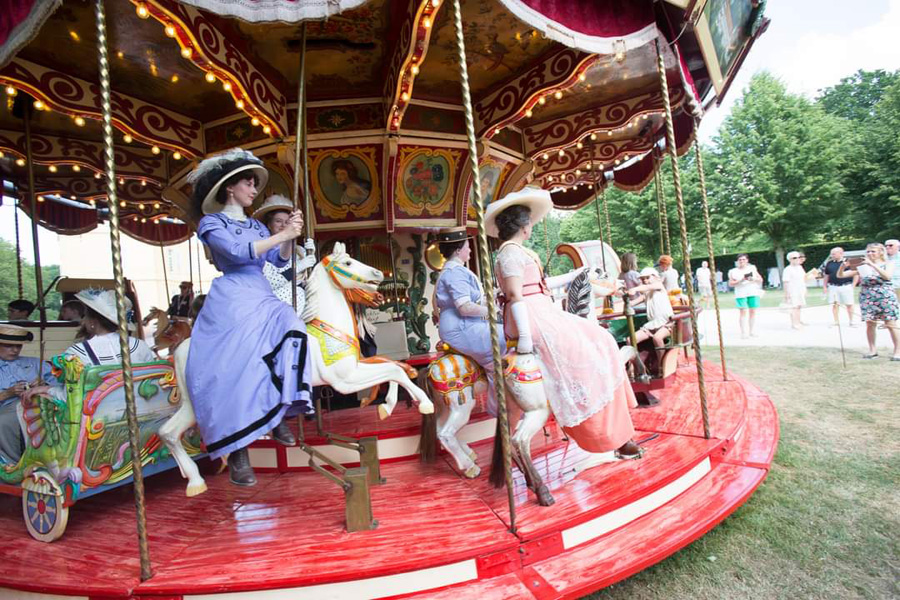In June of this year, I had the opportunity to volunteer as ‘set dressing’ for the Kasteelfeesten at Castle D’Ursel. Held once every two years, this is a historical event with some reenactment, activities for families and general fun in the theme of a historical year of the family which inhibited the castle at that time.
This was my first year attending as volunteer, and our job was basically to scroll around looking fashionably historical, enjoy the day, and participate in some small reenactments. The year it was set in was 1910, and that meant I did need a new dress!
For the day outfit, I scrolled through De Gracieuse of 1910, and settled on this dotted dress:

First step was fabric! I settled on buying a dotted viscose. I knew I wanted a very drapey fabric for the sleek 1910 look, and although the original was meant to be silk or wool, even if I’d found a suitable silk or wool with dots, it’d probably been out of budget. Cotton dots are the easiest to find, but that would most likely be too stiff for what I wanted. I settled on viscose, as that still feels natural, and I actually had a chance of finding a suitably sized dark dot on white background (turns out most fabrics are white dot on color background) while also finding the exact same hand of fabric in a solid matching the dots.

The dotted fabric in the cutting stage 
The dark blue fabric in the hemming stage
My dots ended up being dark blue, not so much as conscious choice, but because that was what I could find online.
For the skirt, I made a rough mock-up based on the pattern with the De Gracieuse picture (which for the skirt is a tiny picture). I drafted a version with a narrower bottom panel, as in the picture. I only pinned it on, but it gave quite a ‘balloon effect’, with the wider top part standing out. Although my drapier fabric and proper sewing would have reduced this, I was scared that this particular design element would still end up looking a bit odd. The original image shows no ‘blooming’ of the wider part of the fabric, and I suspect this will only happen if the dotted fabric is very light, and perhaps even the darker fabric a bit heavier to pull it down.

I didn’t really have time to experiment, so in the end I just decided to cut the fabric more ‘as normal’ with a contrast band at the bottom, but no narrowing of the skirt. Not as highly fashionable perhaps, but still suitable for 1910.
For the top part, I first traced the pattern from De Gracieuse to figure out the pattern lines. The contrast is actually in one piece, which is quite a cool feature.
[picture pattern]
I then took my Wearing History Edwardian blouse pattern (which I’d made before), and applied the contrast fabric piece to that, basically applying the ‘idea’ of the pattern to one that I knew would fit me. This saved a good deal of scaling up and fitting effort. The contrast band is used to gather the main blouse fabric. The point in which it’s sewn in was a bit fiddly, but it looks quite nice when finished. For the sleeves, I went simple, and just made a contrast cuff to the original blouse sleeves. I ended up leaving the bottom of the blouse wide and open, to allow for easier fitting. The blouse closes in the back with snaps.
As I chose to make this dress a blouse/skirt combination (rather than for instance a full dress with lined bodice and skirt attached), I did want to pretty up the waistband a bit. So I made a belt to cover the waistband of the skirt, following the original inspiration in general.
The final step was headwear! As I had so little time, I opted to re-use my 18th century bergere as 1910’s hat. The main difference is that a bergere has a very shallow crown, while 1910’s hats have bigger and deeper ones. To hide this, I followed my friend Birthe’s example and just pinned a whole bunch of tulle on top of the hat. This was left-over bridal tule from my sister in law’s wedding dress, and it worked perfectly to get the right look!
A small last-minute addition was a gold/white ribbon for the suffragette demonstration we were to take part in (yellow-white were the Dutch suffragette colors), and an antique collar which happened to fit over the neckline very nicely.
The day itself turned out to be quite warm, so I was very happy that Julia (Empress of Buttons) was so kind as to lend me a parasol for the much needed shade.
I strolled around, drank a lot of water, danced a bit, marched in a suffragette demonstration, rode some antique cars, took pictures, and in general had an amazing time with a wonderful group of people.

Suffragette march 
Chatting to our drivers 
Waiting to welcome the family 
Riding the carousel 
Waiting to welcome the family












Your dress is beautiful!
Thank you!
That event looks like such fun, and your dress matches it perfectly! I love it!
Thank you! It was a wonderful event.
Pingback: 2023 Year in Review | Atelier Nostalgia
It amazed me how much, aside from the length, this resembles dresses from the 1980s. And then I remembered just how much of 1980s fashion was inspired by 1890s-1910s and 1940s-1950s fashion. The American designer Jessica McClintock had a line of summer wear that was pretty much Edwardian underthings and lingerie dresses repurposed as loungewear, including lace insertion and pin tucks. Even better, much of it was available as sewing patterns from Simplicity.
There’s a lot of historicism, also Edwardian doing Regency, which is in itself trying to do ancient fashions. Some of my favourite vintage are the ’70s does Edwardian’ type of garments.
Sounds like a lovely event! And your dress is super cute. The contrast band around the neckline/sleeves is unusual and neat.
Best,
Quinn
Thank you! That was one of the details which drew me to the design, and for which I was glad to have at least the shape of the pattern!